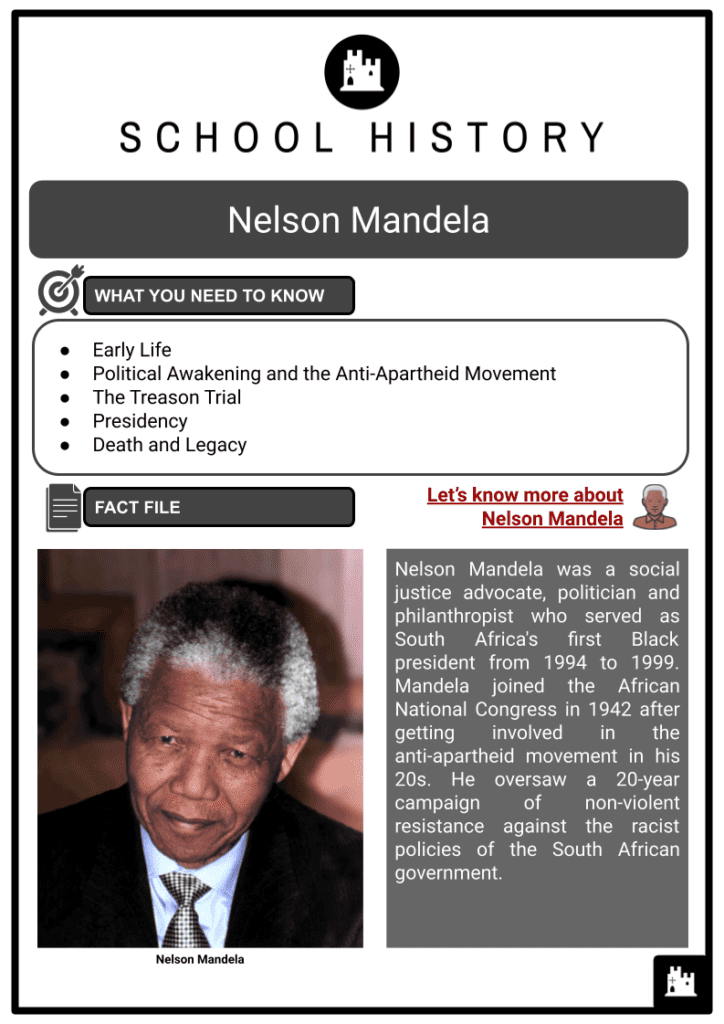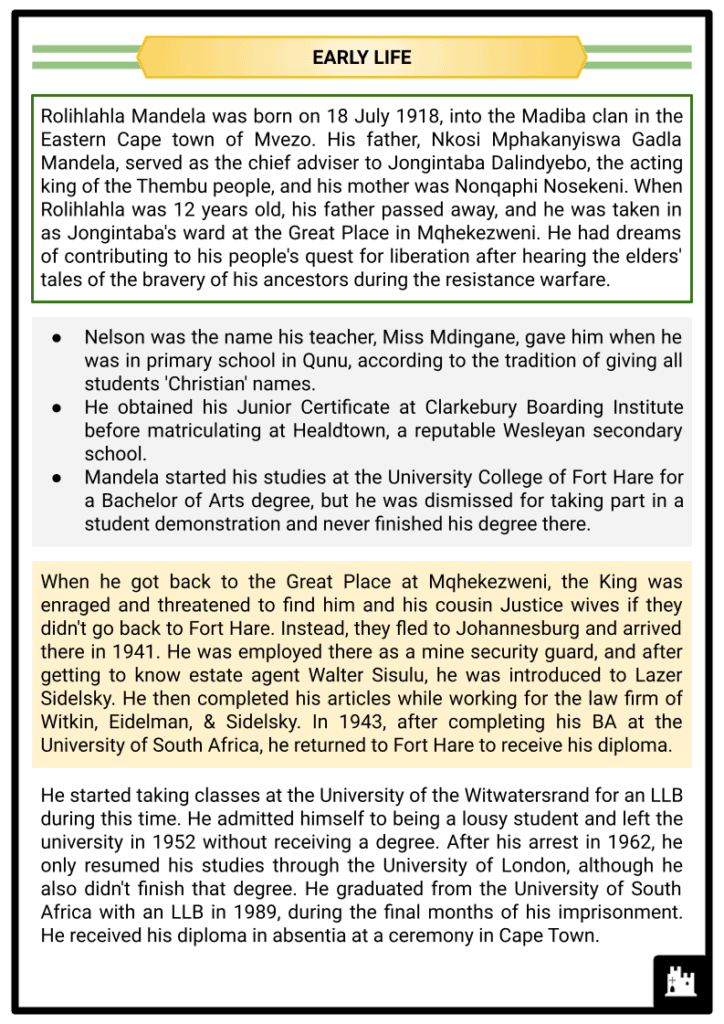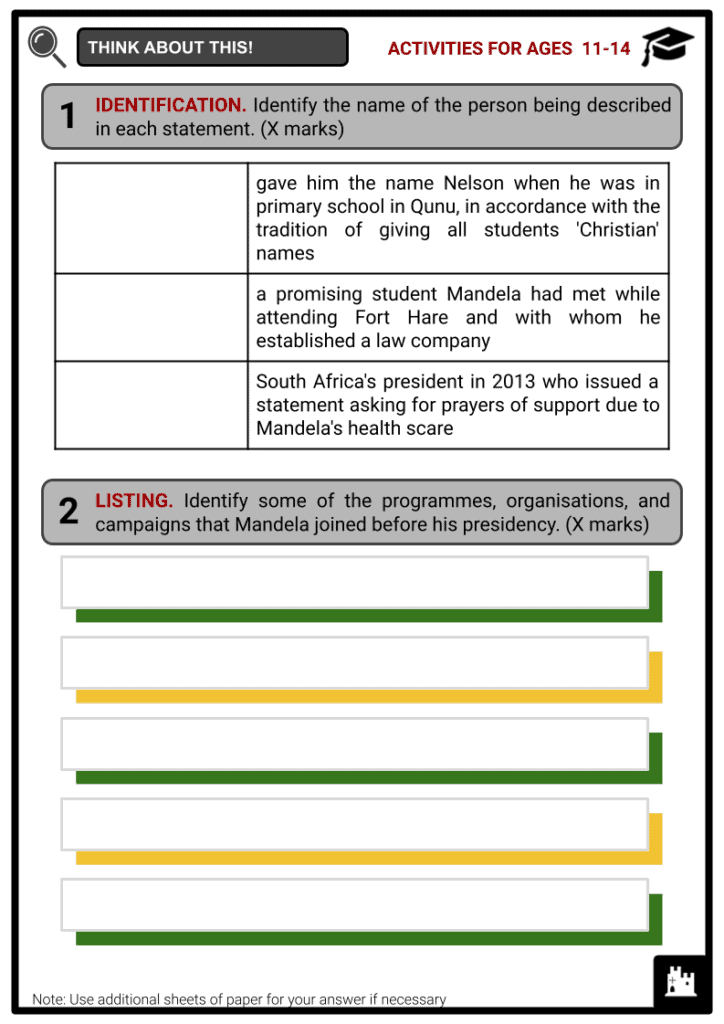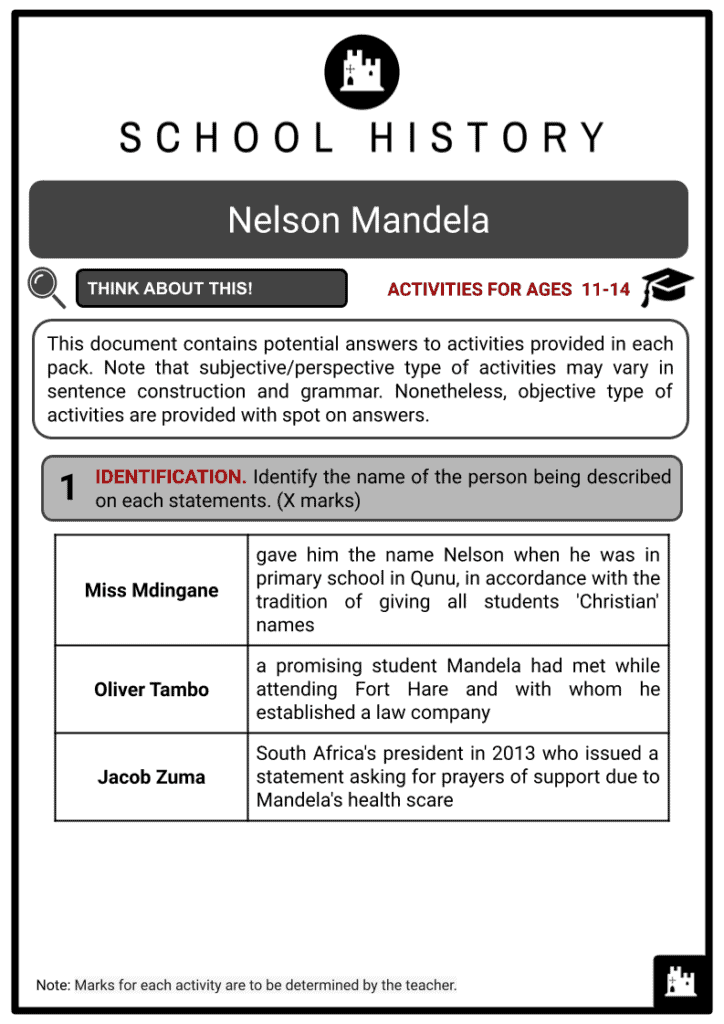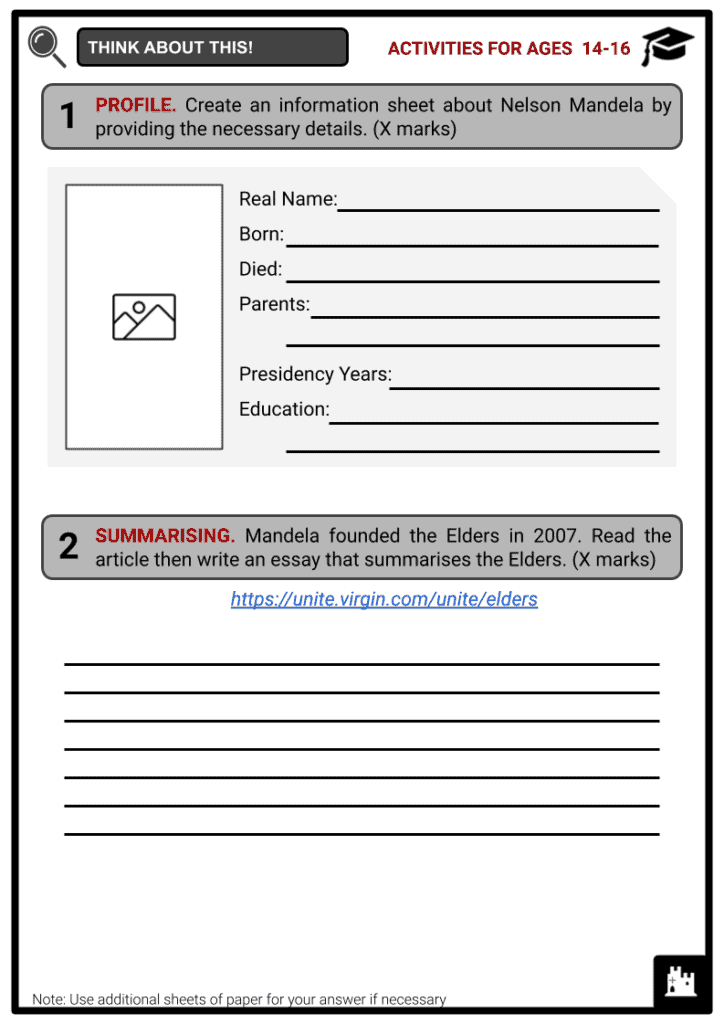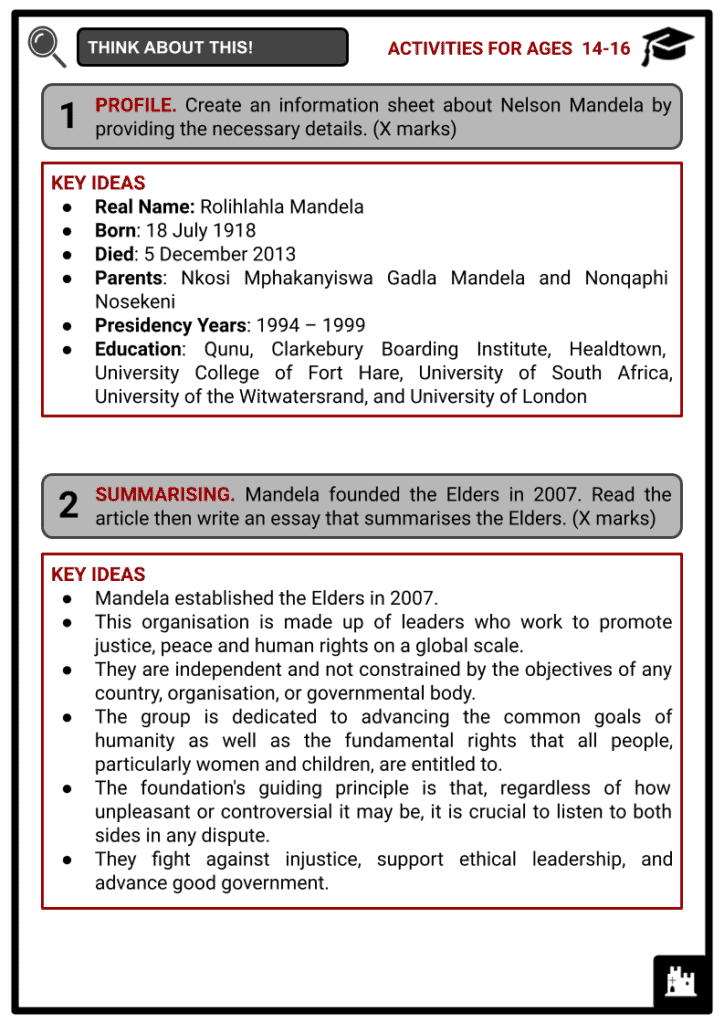Nelson Mandela Worksheets
Do you want to save dozens of hours in time? Get your evenings and weekends back? Be able to teach about Nelson Mandela to your students?
Our worksheet bundle includes a fact file and printable worksheets and student activities. Perfect for both the classroom and homeschooling!
Summary
- Early Life
- Political Awakening and the Anti-Apartheid Movement
- The Treason Trial
- Presidency
- Death and Legacy
Key Facts And Information
Let’s find out more about Nelson Mandela!
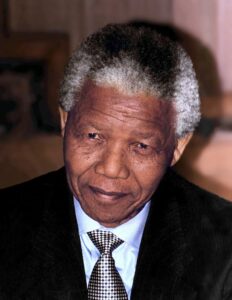
Nelson Mandela was a social justice advocate, politician and philanthropist who served as South Africa's first Black president from 1994 to 1999. Mandela joined the African National Congress in 1942 after getting involved in the anti-apartheid movement in his 20s. He oversaw a 20-year campaign of non-violent resistance against the racist policies of the South African government.
EARLY LIFE
- Rolihlahla Mandela was born on 18 July 1918, into the Madiba clan in the Eastern Cape town of Mvezo. His father, Nkosi Mphakanyiswa Gadla Mandela, served as the chief adviser to Jongintaba Dalindyebo, the acting king of the Thembu people, and his mother was Nonqaphi Nosekeni. When Rolihlahla was 12 years old, his father passed away, and he was taken in as Jongintaba's ward at the Great Place in Mqhekezweni. He had dreams of contributing to his people's quest for liberation after hearing the elders' tales of the bravery of his ancestors during the resistance warfare.
- Nelson was the name his teacher, Miss Mdingane, gave him when he was in primary school in Qunu, according to the tradition of giving all students 'Christian' names.
- He obtained his Junior Certificate at Clarkebury Boarding Institute before matriculating at Healdtown, a reputable Wesleyan secondary school.
- Mandela started his studies at the University College of Fort Hare for a Bachelor of Arts degree, but he was dismissed for taking part in a student demonstration and never finished his degree there.
- When he got back to the Great Place at Mqhekezweni, the King was enraged and threatened to find him and his cousin Justice wives if they didn't go back to Fort Hare. Instead, they fled to Johannesburg and arrived there in 1941. He was employed there as a mine security guard, and after getting to know estate agent Walter Sisulu, he was introduced to Lazer Sidelsky. He then completed his articles while working for the law firm of Witkin, Eidelman, & Sidelsky. In 1943, after completing his BA at the University of South Africa, he returned to Fort Hare to receive his diploma.
- He started taking classes at the University of the Witwatersrand for an LLB during this time. He admitted himself to being a lousy student and left the university in 1952 without receiving a degree. After his arrest in 1962, he only resumed his studies through the University of London, although he also didn't finish that degree. He graduated from the University of South Africa with an LLB in 1989, during the final months of his imprisonment. He received his diploma in absentia at a ceremony in Cape Town.
POLITICAL AWAKENING AND THE ANTI-APARTHEID MOVEMENT
- Mandela underwent the customary African circumcision ceremony to signify his transition to manhood when he was 16 years old. The ceremony of circumcision was a complex ritual, not just a surgical procedure, performed in preparation of becoming a man. An uncircumcised male was not allowed to marry, inherit his father's money or perform tribal rites, according to African tradition. Twenty-five other teenagers attended the ceremony with Mandela. He felt ready to make the shift from boy to man and appreciated the chance to participate in his people's traditions.
- His attitude changed, however, when Chief Meligqili, the ceremony's keynote speaker, spoke bitterly of the young men and revealed that they were slaves in their own land. The chief claimed that, because white men owned their land, they would never be able to exercise self-government.
- He continued to express regret that the young men's potential would be wasted as they struggled to support themselves and carried out pointless tasks for white males. Although the chief's statements didn't really make sense to Mandela at the time, he would later claim that they helped him to solidify his desire for an independent South Africa.
- After joining the African National Congress in 1942, Mandela quickly got involved in the anti-apartheid movement. A small number of young Africans organised themselves within the ANC under the name African National Congress Youth League. They wanted to turn the ANC into a massive grassroots movement that would draw support from the millions of rural peasants and workers who were voiceless under the current government. In particular, the group thought that the ANC's previous petitioning strategies were ineffectual. The Youth League's tactics of boycott, strike, civil disobedience and non-cooperation were formally embraced by the ANC in 1949, along with its policy objectives of full citizenship, land redistribution, trade union rights, and free and compulsory education for all children.
- Through the efforts of the ANCYL, which Mandela ascended through the ranks of, the ANC embraced the more extreme mass-based doctrine known as the Programme of Action in 1949.
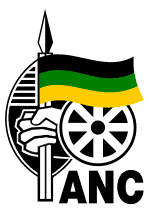
ANC logo - He was elected in 1952 to lead the Defiance Campaign's national volunteer force, serving with Maulvi Cachalia as his deputy.
- The ANC and the South African Indian Congress collaborated on this campaign of civil disobedience against six unfair laws.
- For their involvement in the campaign, he and 19 other people were charged under the Suppression of Communism Act and given a sentence of nine months of hard labour with a two-year suspension.
- Mandela oversaw 20 years of non-violent protests against the racist policies of the South African government, such as the 1952 Defiance Campaign and the 1955 Congress of the People. Together with Oliver Tambo, a promising student he had met while attending Fort Hare, he established the law company Mandela and Tambo. Unrepresented Black persons received free and affordable legal advice.
- Due to his political activism, Mandela and 150 other people were detained and charged with treason in 1956 (but they were eventually acquitted). Africanists, a new generation of Black activists who thought the ANC's pacifist approach was unsuccessful, were challenging the ANC at the same time. The Pan-Africanist Congress was quickly founded by Africanists, which had a negative impact on the ANC: by 1959, the movement had lost most of its violent support.
THE TREASON TRIAL
- On 5 December 1956, Mandela was arrested during a nationwide police operation, which prompted the 1956 Treason Trial. The long trial included men and women of all colours, and it didn't end until the final 28 defendants, including Mandela, were cleared on 29 March 1961. Sixty-nine unarmed persons were killed by police on 21 March 1960, during a demonstration in Sharpeville against the pass restrictions. Because of this, the nation declared its first state of emergency, which resulted in the ANC and the Pan Africanist Congress (PAC) being outlawed on 8 April. Thousands of people were imprisoned during the state of emergency, including Mandela and his Treason Trial co-defendants.
- Days before the Treason Trial concluded, Mandela travelled to Pietermaritzburg to address the All-in-Africa Conference.
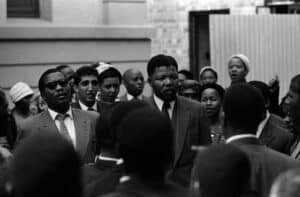
Mandela at the Treason Trial - The conference decided that Mandela should write to Prime Minister Verwoerd to request a national convention on a non-racial constitution and to warn him that if he did not agree, there would be a strike to prevent South Africa from becoming a republic.
- Mandela went into hiding and started organising a nationwide strike on 29, 30 and 31 March after he and his co-defendants in the Treason Trial were found not guilty.
- The walkout was called off early as the state security forces were heavily mobilised.
- He was asked to lead the armed resistance in June 1961, and he worked to form Umkhonto weSizwe (Spear of the Nation), which went on the offensive on 16 December of that year with a series of explosions.
- Under the assumed name David Motsamayi, Mandela smuggled himself out of South Africa on 11 January 1962. To garner support for the armed effort, he visited England and travelled throughout Africa. He returned to South Africa in July 1962 after completing his military training in Ethiopia and Morocco. He had briefed ANC President Chief Albert Luthuli on his trip in KwaZulu-Natal on 5 August, but when he was returning from that location, he was stopped by police at a roadblock outside of Howick.
- He was charged with initiating a strike by his coworkers and evading immigration controls. After being found guilty, he was sentenced to five years in prison, which he began serving at the Pretoria Local Prison. On 27 May 1963, he was taken to Robben Island, and on 12 June he was returned to Pretoria. Within a month, police raided Liliesleaf, a hideout for ANC and Communist Party activists in Rivonia, Johannesburg, and detained a number of his friends.
- In what became known as the Rivonia Trial, Mandela was one of 10 defendants put on trial for sabotage on 9 October 1963.
- Mandela and the other seven defendants – Walter Sisulu, Ahmed Kathrada, Govan Mbeki, Raymond Mhlaba, Denis Goldberg, Elias Motsoaledi and Andrew Mlangeni– were found guilty on 11 June of that year and given life sentences the following day.
- Due to his race, Goldberg was transported to Pretoria Prison while the others were transferred to Robben Island.
- His mother passed away in 1968, as did his oldest son, Thembi, in 1969. He was prohibited from going to their funerals.
- With Sisulu, Mhlaba and Mlangeni, Mandela was moved to Pollsmoor Prison in Cape Town on 31 March 1982. In October, Kathrada joined them. Mandela was kept in isolation when he returned to the prison in November 1985 following prostate surgery. Kobie Coetsee, the minister of justice, paid him a hospital visit. Later, Mandela started discussions on a potential meeting between the ANC and the apartheid regime.
- He was admitted to the hospital on 12 August 1988, and was diagnosed with tuberculosis. He spent the last 14 months of his imprisonment in a residence at Victor Verster Prison near Paarl after spending more than three months in two hospitals. On Sunday 11 February 1990, he was freed from its walls, nearly four months after his remaining Rivonia colleagues had been set free and nine days after the ANC and PAC had been declared no longer banned. Over the course of his detention, he had turned down at least three offers of conditional release.
- In 1991, Mandela was chosen as ANC President to take the place of his sick friend Oliver Tambo. Mandela then immersed himself in official negotiations to remove white minority rule. He and President FW de Klerk shared the Nobel Peace Prize in 1993, and on 27 April 1994 he cast his first-ever ballot.
PRESIDENCY
- Negotiations between Black and white South Africans were successful, in large part because of the efforts of Mandela and President de Klerk: On 27 April 1994, South Africa had its first democratic elections. On 10 May 1994, at the age of 77, Mandela took office as the nation's first Black president, with de Klerk serving as his first deputy. President Mandela struggled to make the switch from minority rule and apartheid to Black majority government from 1994 to June 1999. He encouraged Black South Africans to embrace the once-despised national rugby side as he exploited the country's love of sports as a springboard to encourage racial harmony.
- By hosting the Rugby World Cup in 1995, South Africa entered the international spotlight and elevated the fledgling nation's standing. Mandela received the Order of Merit in the same year as well.
- Mandela sought to prevent the collapse of South Africa's economy while he was president. The South African government sponsored the provision of jobs, housing and fundamental healthcare under his Reconstruction and Development Plan.
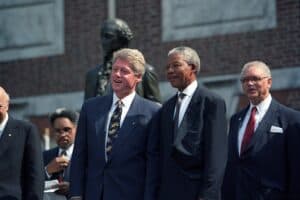
US President Bill Clinton and President Nelson Mandela - A new constitution for the country was enacted by Mandela in 1996. It established a strong central government based on majority rule and protected both minorities' rights and the freedom of speech.
- By the general election in 1999, Mandela had given up on political activism. However, he continued to keep a hectic pace, raising funds through his foundation to construct schools and hospitals in South Africa's rural interior and acting as a peacemaker in Burundi's civil conflict. In 2001, Mandela had a prostate cancer diagnosis and treatment. He officially retired from public life in June 2004 at the age of 85 and moved back to his home hamlet of Qunu.
- In 2010, Mandela made his final public appearance at the World Cup final game in South Africa. In his later years, he remained mainly out of the public eye, preferring to spend much of his time in the Qunu hamlet where he was raised, south of Johannesburg. However, he did meet with First Lady of the United States Michelle Obama, who travelled to South Africa in 2011. When Mandela visited the US in 2005, Barack Obama, then a junior senator from Illinois, also had a meeting with him.
DEATH AND LEGACY
- At the age of 95, Mandela passed away in his home in Johannesburg, South Africa, on 5 December 2013. Mandela had a brief period in the hospital in Johannesburg after contracting a lung infection in January 2011 before having surgery for a stomach issue in early 2012. After a few days, he was allowed to go, and he eventually came back to Qunu. Mandela would require additional tests and medical care for his recurrent lung illness several times over the following years, in December 2012, March 2013 and June 2013.
- In response to public outcry over Mandela's health scare in March 2013, South Africa's president, Jacob Zuma, issued a statement asking for prayers of support. Zuma said, "We appeal to the people of South Africa and the world to pray for our beloved Madiba and his family and to keep them in their thoughts." Zuma made a speech about Mandela's legacy on the day of his passing: "Let us reaffirm his vision of a society... in which none is exploited, oppressed or dispossessed by another, wherever we are in the country, wherever we are in the world," he said.
- Mandela Day, celebrated annually on 18 July to promote world peace and honour the legacy of the South African leader, was established in 2009. It falls on Mandela's birthday. According to the Nelson Mandela Foundation, the yearly event aims to inspire people all around the world to give back in the same way that Mandela did his entire life.
- Mandela's international popularity began to take shape during his incarceration in the 1980s, when he rose to become the most well-known political prisoner in the world, a representative of the fight against apartheid, and a role model for millions of people who accepted the principle of human equality.
- Throughout his activism and political career, Mandela stirred up controversy, drawing criticism from the extremes of the right and left.
- Mandela was widely referred to as a terrorist throughout the 1980s by well-known politicians in the West due to his support of political violence.
- On the website of the Nelson Mandela Foundation, it is stated: "Mr. Mandela gave 67 years of his life fighting for the rights of humanity. All we are asking is that everyone gives 67 minutes of their time, whether it’s supporting your chosen charity or serving your local community."
Image Sources
- https://en.wikipedia.org/wiki/Nelson_Mandela#/media/File:Nelson_Mandela_1994.jpg
- https://en.wikipedia.org/wiki/African_National_Congress#/media/File:African_National_Congress_logo.svg
- https://lh3.googleusercontent.com/ci/AC_FhM93DbwykPeFBm8_M5aGn9KXizEWzfdjL-eQkAw11V-y5QQEFKUuf4bUv8juRF_vM0TH9qt9bIF1=s1200
- https://en.wikipedia.org/wiki/Nelson_Mandela#/media/File:President_Bill_Clinton_with_Nelson_Mandela.jpg

